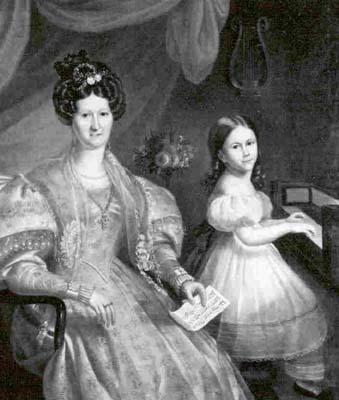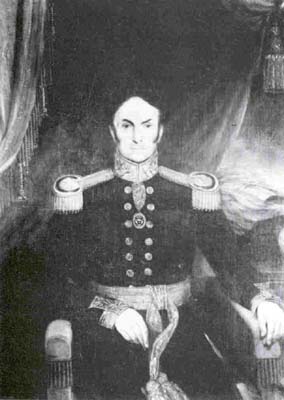
Annual Bulletin 8, 1984-1985
Home
Français
Introduction
History
Annual Index
Author &
Subject
Credits
Contact


Henry D.
Thielcke: A recently Found
Portrait and some Reflections on
Thielcke's Links with the English School
by Ross Fox
Pages 1 | 2
| 3 |
4 | 5
| 6
It also demonstrates a clear connection between contemporary portraiture
in Britain and in Lower Canada. Thielcke shows himself
as still belonging to the English School, whereas Plamondon, a pupil of
the French Academician Jean-Baptiste Paulin Guérin, took pride in
referring to himself as an "élève de l'École française."
Strictly speaking, however, Plamondon's style is a highly personalized
version of its attested French antecedents. In the manner of the followers
of Lawrence, Thielcke's technique verges on the painterly, while retaining
something of the short, delicate brushwork belonging to his activity as
a miniaturist. There is a softness, even bluntness, in the modelling, a
warmth in the tonality, and a use of dark shadows. Plamondon's approach
at that time tended to be more classical. The lighting is more diffuse,
the colours cooler, and the modelling of forms and details are often meticulously
worked and comparatively dry.
But the contradistinction between these
two artists is nowhere more evident than in their approach to women as subjects.
Here their differences emanate as much from individual inclination
as from any specific European influence. The sitter in the portrait by
Thielcke glows amidst sedate refinement. She is imbued with a charm and
a grace, and breathes a warm intimacy, even a quiet sensuality, that again
betokens a debt to Lawrence. In a contrasting example painted in the same
year - Julie Bruneau Papineau and Her Daughter Ezilda (fig. 5) -
Plamondon presents an image of chilling primness with an overlay of antiseptic
prettiness. (32) Moreover, the whole is suffused
with an air of self-conscious propriety and respectability. Other contemporary
portraits by Plamondon are of a similar stamp, for instance, the portrait
of Mary Ann Wragg in the Art Gallery of Ontario. (33) These paintings advertise
an exaggerated claim to social worth by colonial arrivistes, which
was not always respected by the community at large. Thus, it is with derision
that a contributor to Le Populaire (Montreal) of 4 August 1837 (p.
4) comments with specific reference to the portrait of Madame Papineau:
Il paraît que cette dame, toute occupée des projets futurs de son illustre époux, a voulu voir si une couronne siérait bien à sa tête, et elle a eu soin de se faire peindre avec un peigne qui lui donne tout l'air de porter le diadème. Bien des gens, en voyant cette peinture s'écrient c'est encore trop tôt! mais, comme l'a dit un grand homme, les choses vont vite en Canada. (34)
Her husband, of course, was the politician Louis-Joseph Papineau.
Thielcke's group portrait has a similar
air of social aspiration, yet strikes a more felicitous chord in the
easier and more subtle ' 'English ', manner. His painting is a praise
of feminine loveliness in a stylish lady of seeming gentle station. His
sitter is manifestly in touch with the current trends of London couture,
despite residence in the colonies - a fact most evident by the short,
relatively small sleeves of her dress. In the early summer of 1836, sleeves
suddenly diminished in size; before then they were large and ballooned,
like those worn by Madame Papineau. (35) Allowing several months for the transmission
of this style to America, one might surmise that Thielcke executed his
painting later in the year. Furthermore, a notice in The Quebec Mercury
of 29 October 1836 (p. 3) announces Thielcke's return from a visit
to New York City. The extent of this trip is uncertain, but could the Ottawa
portrait perhaps date afterwards?
Only one other painting by Thielcke
from the year 1836 is presently known. It is a portrait of Archibald Acheson,
2d Earl of Gosford, who was Governor-in-Chief of British North America
from 1835 until 1838 (fig. 6). (36) Lord Gosford is painted three-quarters
length, in uniform and erectly seated, his head and upper torso strictly
frontal. The fundamental conception is of a stiff reserve and formality
coupled with a concentration on essential insignia - in effect, public
declarations of power and authority. Stateliness prevails in the picture,
which falls within the confines of official portraiture. A particularly
austere dignity is conveyed by the abstract patterning of vertical braided
tassels, which reappear throughout the composition (the large tassel
at upper right and the tasseled fringes of the drapery at the left, of
the governor's epaulets, and of the upholstered arms of the chair). The
employ of formal devices is almost artificial in its overplay, yet lends
at least the semblance of a powerful iconic quality.
Without question The Earl of Gosford
is the finest of Thielcke's Canadian single portraits yet to come
to light. Only seven of his portraits from after this time are known,
spanning some two decades. Except for one, all treat individuals.
As a whole, they are generally rather dismal half-length productions of modest formulation,
with their subjects often whelmed by heavy shadows, but for the most part
a proper appreciation is impeded by their pitiful state of preservation,
which owes something to a faulty artistic technique - for instance, Thielcke's
excessive use of bitumen. (This is a further trait reflecting current
English practice, bitumen being much used by Lawrence in his later years
to effect very dark, even blackish tonalities, particularly in clothing
and backgrounds. Through Lawrence's influence, its use became a mark
of much English portraiture of the 1820s and 1830s.)
The only other Canadian painting
by Thielcke that is known is a group portrait painted in 1840, The Presentation
of a Newly Elected Chief of the Huron Tribe, Canada now in the collection
of the Château Ramezay, Montreal. This work greatly appealed to
Thielcke's contemporaries and was reproduced in a popular coloured lithograph
published by H. Lynch, Day & Haghe in 1841. (37) Even now it is his best
known painting, but its celebrity has always been due to its subject;
as a work of art it is less meritorious. Above all, Thielcke had difficulty
in composing a full-length multi-figured group - admittedly a demanding
assignment. Perhaps more than any other factor, it is the limitations of
this particular painting that have inhibited a fair estimation of Thielcke
as an artist.
Do the later paintings reflect a degeneration
of Thielcke's artistry, or even a change in clientele? Do they signify
artistic atrophy induced by a relatively sterile colonial environment?
Those are questions for future exploration. Let it be said that a similar
decline can be detected among many of the followers of Lawrence in Britain
during this same period. (38)
The fortunate discovery of the Ottawa Portrait of a Woman and Child,
which contrasts so clearly with these
lesser works, now allows us to see the considerable mastery of which Thielcke
was capable. The portrait may prove to be an anomaly within his Canadian
oeuvre, yet it has considerable significance in suggesting the potential
of a keen rivalry with Plamondon in talent. Whether conditions in Lower
Canada were conducive to the full exploitation of such talent is doubtful:
the fact remains that Plamondon was the fashionable portraitist of
the day, while Thielcke was in lesser demand.
Considered in other terms, the Ottawa
portrait reveals that Thielcke offered a definite stylistic alternative
to Plamondon's portraiture. It shows him four years after his arrival in
Canada still drawing his primary inspiration, even if by then outmoded,
from the English school. His portraiture stands in contrast to the distantly
French-influenced and more personalized portrait style of Antoine Plamondon,
and to an even greater degree to the naive attainments of still other provincial
limners such as Jean-Baptiste Roy-Audy. Certainly, the discovery
of the Ottawa portrait demands a fuller examination and a reassessment
of Thielcke's role as a portraitist in Lower Canada, a role that has been
almost completely neglected up to the present time.
Next Page | Notes 1 to 22
1 | 2
| 3 |
4 | 5
| 6
Annual Index | Author & Subject | Credits | Contact
This digital collection
was produced under contract to Canada's Digital Collections program,
Industry Canada.
"Digital
Collections Program, Copyright
© National Gallery of
Canada 2001"